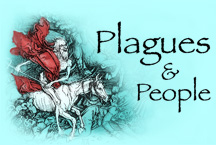| The hooping-cough, like the small-pox, measles, and the venereal disease,
never appeared in Europe originally, but was transported thither from other
parts of the world by means of merchandise, seamen, and animals:
it was a new disease to our ancestors in Europe, and probably was conveyed
to them either from Africa or the East Indies, where it was rooted before.
Its first appearance in Sweden cannot be determined with any certainty;
but in France it began in the year 1414.
It is likewise observable that the hooping-cough always appears as an
epidemical disease. I think its nature is easily to be understood,
since I have many times plainly perceived it to be contagious, and that
it infects only such children who have not yet had it. Therefore
it infects in the same manner as the measles or small-pox. I knew
the hooping-cough conveyed from a patient to two other children in a different
house by means of an emissary. I have even myself carried it from
one house to another undesignedly.
A person who has once had the hooping-cough is as secure from the danger
of catching that disorder again as those who have had the small-pox and
measles are with regard to those respective diseases. During my practice
I never found or heard of any one who has been infected with the hooping-cough
more than once.
It comes on only by degrees, and is at first dry, but when it has continued
ten or twelve days, it turns humid, and the matter which is then coughed
up looks ripe; nevertheless it increases more and more, leaving long intervals;
the fits return at certain hours, but continue at each time with such violence
and for so long a time, that the child grows blue in the face, its eyes
look as if they were forced out, and they run besides, and a bleeding of
the nose is sometimes brought on; it coughs till it is quite out of breath,
that one is in apprehension of its being choaked; for if the patient now
and then is capable of drawing some breath, it is with a sounding, which
very much indicates with what difficulty the lungs can admit the air.
The coughing continues, and does not leave off for that time, till the
child vomits up a quantity of slime. If at any time the coughing
should intermit without the paroxysm being ended with a vomiting, it will
immediately return again, and will not cease but after a vomiting.
If the paroxysm happens to come on immediately after the child has taken
nourishment, it will grow blue in the face, stumble, and be stifled if
one does not quickly excite vomiting by irritating its throat with a finger.
Therefore such patients should not be left alone by themselves, but be
attended by a sensible person who has a presence of mind, and who will
besides be of service in preventing them from hurting themselves, for they
will generally tumble down during the fit. However, they commonly
lay hold of something, when the coughing, seizes them, for instance a chair
or table, keeping it fast with all their strength, whilst they during that
time are stamping with their feet.
The chincough is called Coqueluche in France, because
they formerly thought it to arise from a running of the head, and that
it was to be cured by keeping the head warm by a cap. We have not
received any particular name for the chincough from the ancient Romans
and Greeks, as it was not then known to them.
It is worth our while to take this into consideration; for the disease
is both tedious and severe. When it is left to the course of nature
alone to be worked out, it commonly will last eleven or twelve weeks, nay
frequently half a year. What is still worse, the disease is very
dangerous and often fatal. A number of patients are stifled by it,
getting convulsions and apoplexies, others pine away entirely, others again
are puffed up by it and die. Besides a great number contract ruptures
hereby, or become deformed. |

